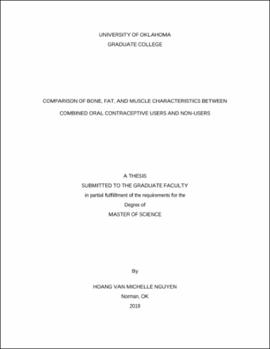| dc.description.abstract | Combined oral contraceptives (COC) are widely used as a form of birth control or to reduce negative symptoms associated with menstruation. However, many women discontinue use or fail to initiate use of COC because of the fear of weight gain or negative effects of body composition (1). Increased weight gain has been linked to increases in % body fat in some studies (2-5); however, others have not found this effect (1, 6). Despite this, the possibility of decreased functional muscle due to increased lipid infiltration is cause for investigation. Additionally, decreased endogenous estrogen levels caused by COC use may stunt bone accrual during young adulthood (7, 8). Purpose: The purposes of this study were to: (1) compare areal bone mineral density (aBMD) of the total body, lumbar spine, and proximal femur; and volumetric bone mineral density (vBMD) characteristics of the femur and tibia between COC users and Non-Users; (2) to compare muscle variables such as muscle thickness, muscle cross-sectional area (mCSA), muscle density and muscle quality between COC Users and Non-Users; and (3) to compare fat density and subcutaneous fat cross-sectional area (sfCSA) between COC Users and Non-Users. Additionally, bone, muscle, and fat variables were compared between Non-Users, Low Dose COC, and High Dose COC users. Methods: Forty healthy college aged women were assigned to Non-User or COC User groups based on COC use. Body composition and aBMD measurements were performed using dual energy x-ray absorptiometry (DXA). Peripheral quantitative computed tomography (pQCT) was used to measure volumetric bone mineral density (vBMD) at the 50% femur site and the 4%, 38%, 66% tibia sites. Images of the 50% femur and 66% tibia site were analyzed using BoneJ software to determine soft tissue characteristics. Lastly, muscle thickness (MT) measured using an ultrasound and maximal isokinetic torque (MIT) of the non-dominant quadriceps muscle using a Biodex isokinetic dynamometer were utilized to quantify muscle quality (MIT/MT). Independent t-tests were run to compare Non-Users and COC Users. ANOVA was run to compare Non-Users, Low Dose COC, and High Dose COC Users. Effect sizes were determined for all variables for the 2 and 3 group comparisons. Results: Age of menarche was higher in COC Users (12.9 ± 1.3) compared to Non-Users (12 ± 1.1) (p=0.044) and higher in High Dose COC Users (13.5 ± 1.1) compared to Non-Users (p=0.009). There were no significant differences between Non-Users and COC users for any of the bone or soft tissue variables for DXA or pQCT measures. No significant differences were found between Non-Users, Low Dose COC, and High Dose COC users for any variables. There was no significant differences in MIT or MQ between Non-Users and COC Users or between Non-Users, Low Dose COC, and High Dose COC. Conclusion: COC had similar bone, muscle, and fat tissue characteristics as women not taking COC. Additionally, COC dose did not affect any of the musculoskeletal variables in this cohort of women. However, moderate effect sizes for most of the variables with the 2 and 3 group comparison suggest that COC may have some effect on bone, muscle, and fat tissue, but lacked the number of participants needed to find significance. Future studies should focus on recruiting larger samples sizes to provide greater statistical power for examining effects of COC use on bone and body composition. | en_US |
